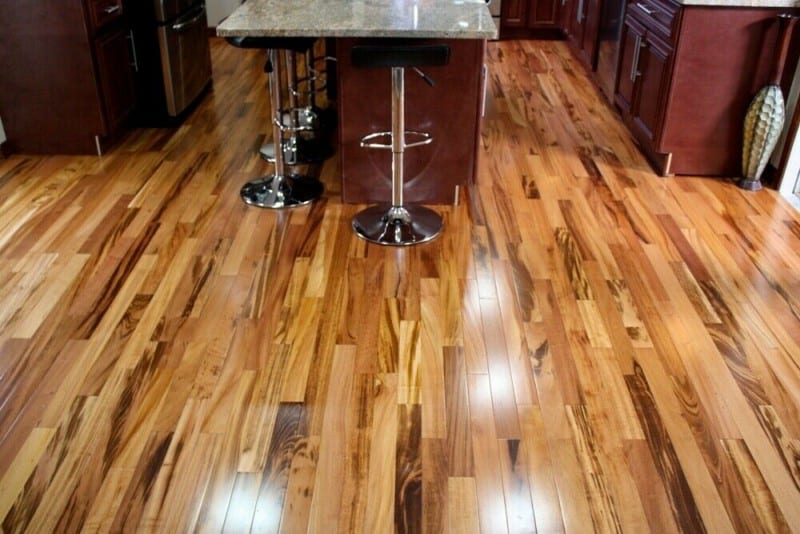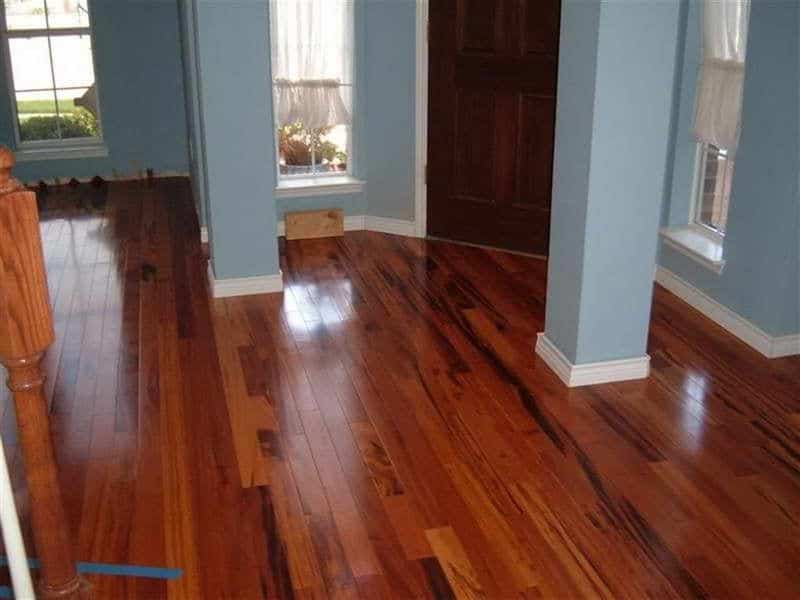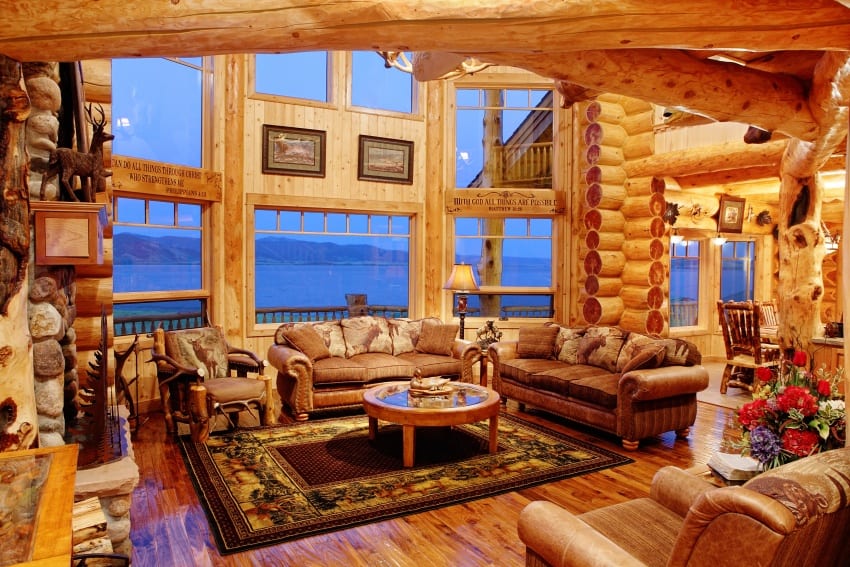Yes, this type of wood flooring got its name from the jungle animal. But that doesn’t mean it’s either dangerous or frightening. In fact, this exotic wood (also called Brazilian Koa Hardwood) is one of the first choices of decorators eager to install a tough, gorgeous hard wood that’s easy to clean and attention-getting. To help you learn more about this exotic wood, keep reading.

What is Tigerwood?
Just in case you haven’t been staying abreast of hardwood flooring trends – but you love discovering woods that give rooms a new look – tigerwood has been gaining a lot of attention over the past few years, as evidenced by the number of interior decorators, designers, architects and home builders who are discovering this unique wood type.
Grown in Brazil, Uruguay, Paraguay and Bolivia, tigerwood has become the darling of lumber industries that are having a hard time keeping up with demand.
It’s easy to see why tigerwood is popular. From durability to dramatic color palettes, this wood is also known as African walnut, goncalo alves, Brazilian koa and zebrawood.
From oranges to browns, tigerwood’s rich appearance is preferred because floors look expensive, sophisticated and elegant, especially when compared to lackluster traditional woods like maple and oak.

Tigerwood is something of a chameleon: it darkens when its exposed to lots of sunlight, so this wood follows in the roots of other South American woods that are classified as exotics.
Nations working aggressively to monitor tree harvesting throughout South America point to the fact that this tree is a fast-growing species so replenishment takes less time than slower-growing trees.
That stated, if you’re concerned about the environment and want to do everything possible to choose green options, ask for tigerwood that carries Forest Stewardship Council (FSC) certification, so you know that the wood was responsibly and sustainably harvested.
Having said that, let’s now see some pros and cons of Tigerwood as a flooring material:
Advantages of Tigerwood Flooring
- -Tigerwood’s Janka hardness rating is 2160 (harder than hickory and maple), so even heavy traffic won’t diminish its beauty and durability.
- -Due to the height of the trees from which tigerwood planks are cut, finding extra-long lengths of these boards isn’t hard, so your floor would have fewer plank seams than other woods.
- -Given the nature of this wood’s biology, it easily compares to teak, which is also known for being a high-density wood with an abundance of natural oils that offer exceptional water resistance. Once sealed, tigerwood rarely warps, cracks or rots, even in damp environments.
- -Insects and bugs avoid tigerwood because it’s too hard to infiltrate, so if you live in an area with a preponderance of bugs and pests – especially beetles – this flooring will remain impervious to attacks by a number of different species.
- -Tigerwood is easy to maintain. Regular vacuuming to rid floors of tracked-in soil, debris and dirt may be all that’s needed to keep it looking pristine. That stated, liquids used to either mop up this type of flooring — or spills that occur – must be tended to fast so the integrity of the wood is maintained.
- -Durable and beautiful, tigerwood flooring could increase the value of your home when you decide to sell.
- -Given its distinct, tiger-like grain, it’s easier to make your tigerwood floor the focal point of a room and since this wood is warm, it’s easy to find colors that enhance your color scheme.
Disadvantages of Tigerwood Flooring
- -Expect to open your wallet wide if you decide that nothing less than tigerwood will give your home or office the look you want to achieve. This wood is expensive (although not as expensive as other types such as ebony, teak, ipe etc).
- -To avoid mars and scratches, wood experts recommend felt pads under furnishings and rugs installed in the rooms subject to the most amount of heavy traffic.
- -To keep your tigerwood floor from becoming changing color, invest in light-filtering window treatments or your floors could darken over time. This process could begin immediately or take 10 years.
- -Because carbon-tipped blades are required to cut tigerwood at lumber mills, installation is best left to professionals. Given the expensive of this material, you could take a big financial hit if your floor installation experience has been limited to traditional, easy-to-cut lumbers.
- -There appears to be a disagreement among flooring experts about tigerwood’s Janka rating. Some claim the often-touted 2160 is more accurately 1850. The dispute is likely the reflection of differences between clear and common grade woods.
- -While the tigerwood tree isn’t endangered, ecologists warn that perpetual wildfires and over-logging could limit supplies and drive up the price substantively. Further, if government forestry regulations are enacted to protect tree farms, obtaining this beautiful wood could become difficult.
- -While contractors find plenty to disagree about related to tigerwood installation, there is 100-percent agreement on the topic of who should be laying these floors: This is not the wood best suited to DIY efforts.
Cost of Tigerwood Flooring
While flooring experts agree that tigerwood flooring is less expensive than hard-to-get ipe, teak and ebony, you can expect pricing to fall within the mahogany and cumaru price range.
According to HomeAdvisor.com, tigerwood belongs in the same class as mahogany and cypress woods and you can expect to spend between $8 and $18 per square foot for the wood and between $4 and $8 for the installation.
HomeGuide.com resources recommend taking your time when searching for your tigerwood flooring because your location, the size of the area you want to floor and the current state of the tigerwood market can impact the amount of money you spend.
Editors suggest shopping online, at local dealers and if one is near you, at lumber liquidators. Your chances of finding Tigerwood online are good, but nothing substitutes for getting your hands on floor samples so you can bring them home. Getting three estimates is always a wise move.
Is tigerwood used just for flooring?
The answer is no. This hard, versatile and beautiful wood, capable of maintaining its integrity and look for up to 50 years, is also used to make musical instruments and fine furnishings like seating, beds and tables.
Because it is water-resistant, it’s commonly used for outdoor decks, boats and furnishings made for patios and porches.
Visit Pinterest pages to see all manner of projects undertaken by professionals and amateurs that include tigerwood railings, decorative hair combs and accessories, kitchen countertops, guitars, wood block kitchen accessories, benches, carved lamp bases and wall sconces.
Add cabinets, utensil handles and brushes to the list, as well as trays, works of art and even jewelry.
In Which Home Rooms to Use Tigerwood Flooring?
If you have a passion for this wood, you probably think that tigerwood would look fabulous in every room of your home, but given its expense and the need to find a professional used to working with this wood, some rooms may be more appropriate for tigerwood floors — especially if your goal is to make a traffic-stopping impression.

Decorators recommend these rooms as ideal candidates for tigerwood flooring:
- -Use tigerwood for your entryway to make an immediate impression on everyone crossing your threshhold. Entryways tend to be smaller areas so you may not have to spend a fortune to get the dramatic look you seek.
- –Dining rooms — where carpeting is an invitation to stains and spills — are ideal candidates for tigerwood. Because this flooring is so dramatic, you don’t have to fill the room with lots of furnishings to make your statement and post-meal clean up is as easy as damp mopping.
- -Because it’s sturdy enough to install inside and out, if your family room is located steps from your wood deck, you can use the same tigerwood to floor both and optically expand space, eradicating the barrier between indoors and outdoors.
- -All types of living rooms. Whether your décor preferences are turning your living room into a sanctuary plucked from a Bavarian ski lodge and furnished in the craftsman style or you prefer your space to be an homage to modern minimalism, tigerwood fits perfectly into these decorating schemes and more.
- Finally, if you are seeking the ultimate sustainable wood, knowing that your tigerwood floor could last for 50 years with proper care and understanding that a day may come when it’s hard to get, flooring every room with tigerwood isn’t a bad idea at all!
Resources
https://www.uniquewoodfloor.com/blog/looking-closer-at-tigerwood-flooring/
https://www.homeadvisor.com/cost/flooring/install-wood-flooring/
https://www.pinterest.com/sjhardwoodfloor/tigerwood-is-everywhere/
https://www.timbertown.com/all-about-tigerwood/
Related Posts
- Different Types of Finishes That Make Concrete Floors Aesthetically Appealing
- 10 Main Pros and Cons of Acid Stained Concrete Floors
- 3 Methods to Remove Candle Wax From Your Carpet (With Iron, Hair Dryer, Natural Products)
- 13 Types of Carpets for Your Home (By Material, Pile, Padding)
- How Much Does it Cost to Epoxy a Garage Floor? All Details Below
- 20 Different Types of Tiles for Home Flooring, Walls, Countertops, Backsplash
As an exotic hardwood, tigerwood isn’t the cheapest thing you could put on your floor, but it is less expensive than ipe, teak, and ebony. Typically, you’ll find the price comparable to mahogany and cumaru. It’s an economical option if you’re looking for a highly durable, moisture-resistant wood with distinct coloring.
Regards,
Harold